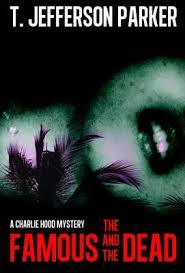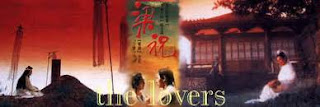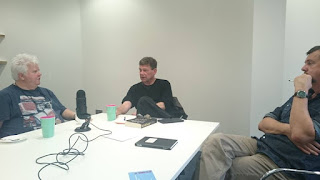
While I watched bits of the World Series, getting into November, which had a great ending as Kansas City beat the Mets, I was also reading a World Series book, David Halberstam's account of the Series in 1964. It was the end of the New York Yankee dynasty: the St Louis Cardinals beat the Yankees in seven games, the Yankees fired manager Yogi Berra (you can link to my obituary of Yogi
here) and hired the Cardinals' Johnny Keane and began a tailspin that lasted until George Steinbrenner in the 70s created the Bronx Zoo teams and instituted a policy of buying the best players from the teams that beat New York.
While Halberstam's book, which was published in 1994, gives a good account of the surprising regular season (in which both teams could've been counted out, and don't forget the Phillies' remarkable collapse) as well as the Series (remember, these were the glorious days before interminable wild cards and playoff series); he has wider concerns. He opens with a quote from George Romney (Mitt's father) speaking about the fate of General Motors: "There is nothing more vulnerable than entrenched success." The Yankees, of course, were the General Motors of baseball, the Cardinals had once been Ford to their GM, before New York's three teams took over domination of baseball just after WWII. He contrasts the teams nicely: the Cards a team with young talent brought along by Keane's teaching hand, the Yankees a team of fading and aging superstars, held together by Yogi's confidence in his former teammates and easy-rider approach to clutch games.
The Cardinals were also a team benefiting from black stars:

Bob Gibson just reaching his peak as a dominant pitcher; Lou Brock, set free by Keane to play his kind of game; Curt Flood covering acres in center field, Bill White a steady rock of a leader at first base. The Yankees, in contrast, had catcher Elston Howard. The National League had got the jump on the American in racial terms, and it was starting to show. Moreover, these players were part of a a new wave of black stars: college-educated, unwilling to sit in the back of the bus, demanding to be respected as men as well as players.
Halberstam is concerned with race here, and because his stories are almost always built around people, his picture of the way changing racial mores reached baseball and reflected changes in America is brilliant. Likewise he recognises that the times were changing on a generational basis too: younger players with different attitudes were reaching the big leagues, players with more options, like the Yankees' Jim Bouton or Pete Mikkelsen, or the Cards' Ray Sadecki. They clashed with managers or veteran players simply because they began to question the entrenched hierarchies of how things were done.
The teams were different too in the way they were built. The Yankees were used to having a mighty farm system, always developing new stars, and players they could trade away for veteran role players. But owners Dan Topping and Del Webb (who oddly barely gets a mention) were looking to sell the team, and cutting their losses (they would sell to CBS after the season) so the farm system was run down. How cheap were they? With the Yankees down three games to two in St Louis, management had the players check out of the hotel and bring their bags to the ballpark before Game Six, even though a Yankee win would mean a game seven the next day. The Yanks dutifully won anyway.
The Cardinals themselves had once been run by a cheapskate of Olympian proportions them, Branch Rickey, who crafted the farm-system blueprint, and they were still producing talent, but this team was built on astute deals by current GM Bing Devine-- bringing in Dick Groat, Curt Simmons, and most importantly Brock (for Ernie Broglio)-- but Devine clashed with team owner Gussie Busch (of the Budweiser fortune) and Busch brought back Rickey, numbering Devine's days.
Baseball was changing, though Topping and Webb had bought the Yankees from Jake Ruppert, another beer baron, the days of owners who made their livings off their baseball clubs, and tended to either know the game well or know that they didn't and left the club to those who did, were ending. Busch was the epitome of the modern owner, who treated the team as his plaything, and the players and staff as his indentured serfs. Soon Curt Flood would mount the first assault on baseball's servitude, with a lawsuit to end the system which bound a player to his team by a series of automatically renewable one-year contracts, the infamous 'reserve clause'.

As baseball's owners changed in nature, so did the players, and eventually, bankrolled by TV, our modern free-agency era would begin, though not without huge unrest.
We know some of the stories well: most notably Mickey Mantle, the Yankee superstar brought low by injury: I had forgotten that in this series Mantle was moved to right field and Roger Maris played center field (Maris would soon wind up in St Louis, out of the New York spotlight he hated). Whitey Ford, their ace pitcher, was also on his last arms, and was not a factor after the series' first game. Halberstam tells those stories, but he actually spends more time on the Cardinals, whose tale transcends baseball to society better, and also is the one we don't know that one so well. And because he writes so brilliantly, (
The Teammates is one of my favourite baseball books) it works wonderfully.
A couple of sidebars: Oddly, in Halberstam's previous baseball book,
the Summer Of '49, I was puzzled by one thing he wrote, that the Red Sox had moved Johnny Pesky from shortstop to third base because he was quicker and had more range than Junior Stephens. No one gets moved from short to third because they have more range, at least they didn't until the Yankees moved Alex Rodriquez to allow Derek Jeter to remain at short. Stephens was a Cal Ripken-like big shortstop whose strong arm allowed him to play deep and gave him more range. There's always something that makes you wonder how accurate the things you don't know about are. In his book on Bill Belichick Halberstam credited Belichick (as captain) and new coach Terry Jackson for turning around Wesleyan's lacrosse programme; but having been there and played the year before Terry took over, I could tell you a large part of the turnaround came when Wesleyan stopped playing bigger Division One programs like Yale, Brown, UMass, Washington & Lee, UConn or New Hampshire.
Anyway, in this book Halberstam mentions Frankie Frisch (the Fordham Flash) and calls him a 'former New York Giant great'. Which was true in the 20s, but Frisch, who fell out mightily with Giants' manager John McGraw, was traded to St Louis for Rogers Hornsby and had a a second great career as player-manager and leader of the 'Gas-House Gang', the great Cardinal teams in the 30s. In a book about the Cardinals that description would seem more relevant.

As I said I was watching the Series while I read this book, and I was thinking what a mistake-prone series it was: sloppy fielding and bad execution of basic baseball. But reading Halberstam's account, I was reminded of how many bad plays characterized this series as well: Phil Linz, the Yankee reserve infielder forced to play short by Tony Kubek's injury, but also Mantle's struggles throwing and numerous other errors, many forced by the faster game the Cardinals, led by Brock and Flood, played.
They are gorgeous memories anyway, and there are few writers who can bring them alive, and give them such depth and humanity, as Halberstam. I met him once, when we were both covering the Chicago Bulls in Paris (I was writing for USA Today; he was researching his book on Michael Jordan). We went to dinner, and he was not only the most interesting man at the table, he was the most interested: you could see just why his interviews gave him so much material. The blessing is how deftly he used it.
 It was New Year's Eve and I went into the City with my college roommate Winsor H. Watson III, and his girlfriend Suze, and their high school friend, then at Smith, Sarah McElhone, who had tried and failed to seduce me in her dorm room while introducing me to Judy Collins' wonderful album In My Life.
It was New Year's Eve and I went into the City with my college roommate Winsor H. Watson III, and his girlfriend Suze, and their high school friend, then at Smith, Sarah McElhone, who had tried and failed to seduce me in her dorm room while introducing me to Judy Collins' wonderful album In My Life.  with 'Time Has Come Today'. The song always takes me back to that place; I was 17, away at college, and my world was a rapidly psychedelicizing oyster.
with 'Time Has Come Today'. The song always takes me back to that place; I was 17, away at college, and my world was a rapidly psychedelicizing oyster.













































